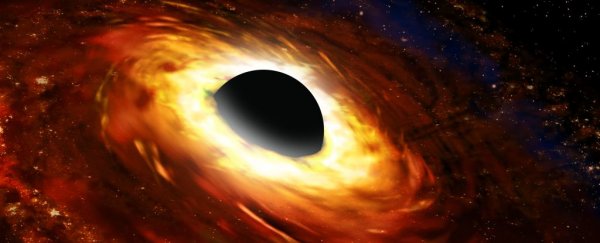Echoes of light bouncing off thick clouds of material around active black holes are helping astronomers better understand the wacky space-time in the immediate vicinity of these extreme objects.
Within the Milky Way, astronomers have just identified eight new examples of these echoing black holes. Previously, only two had been identified within our galaxy.
Having such an expanded number so close to home is allowing a much closer study of these fascinating objects, with the unique insight they can offer into black hole physics.
Stellar-mass black holes – those that formed from the collapse of a massive stellar core – are thought to be fairly common in the Milky Way.
There are as many as a billion of the things drifting around the galaxy, but they're pretty hard to detect; to date, we've only identified a few. That's because, unless they're active, they don't emit any radiation we can detect. They're effectively invisible.
However, when black holes are active, it's a different story. An active black hole is one that has snared something in its gravitational web, and is gradually devouring it.
The material forms an accretion disk of dust and gas swirling around the black hole and falling into it, a lot like water circling and sliding down a drain. The insane frictional and gravitational interactions involved generate intense heat and light, causing the region around the black hole to glow.
In rare black holes, we can also see a fascinating phenomenon at work. Every now and again, the region just inside the rim of the accretion disk closest to an active supermassive black hole flares brightly – when this flare of light reaches the dust, it is reflected back – an echo.
Led by astrophysicist Jingyi Wang of MIT, a team of researchers used a new automated tool called the Reverberation Machine to scour all the archival data from NASA's NICER X-ray observatory, looking for the telltale signs of black hole echoes.
This search turned up eight systems – binaries containing a black hole, with a binary companion star being gradually stripped and devoured by the black hole.
"We see new signatures of reverberation in eight sources," Wang says. "The black holes range in mass from five to 15 times the mass of the Sun, and they're all in binary systems with normal, low-mass, Sun-like stars."
Although rare, these echoes can tell us a lot about the environment around a black hole. The light can be analyzed, from both the initial outburst and the echo, to measure the space between the black hole and the dust, much like a bat uses echolocation to navigate its surroundings.
Black hole echoes can also be used to study how a black hole's corona and the accretion disk change as the black hole "feeds". The corona is the region of scorchingly hot electrons between the inner edge of the accretion disk and the event horizon.
Next, the team analyzed the 10 X-ray-emitting binary systems, dividing the data into groups with similar time lags between the initial X-ray burst and the echoed light. This allowed them to track the changes in the X-ray echoes, to develop a general picture of how the black hole changes during an X-ray outburst.
First, the black hole starts off in a "hard" state, generating a corona and emitting high-speed jets of plasma from the regions over its poles. When these processes are dominating the black hole's energy profile, the time intervals between the X-ray bursts and their echoes are short, on the scale of milliseconds.
This state lasts for a few weeks, before calming down into a "soft" state dominated by lower-energy X-rays from the accretion disk. During this transition, the time intervals between the bursts and the echoes lengthen.
Because the speed of light is constant, this growing time lag suggests that the distance between the corona and the disk is lengthening.
The team thinks that this might mean that the corona expands upwards and outwards as the feeding event tails off and the black hole quietens down, until the next feeding frenzy of material stripped from its stellar companion.
It's not entirely clear yet, but the results have implications not just for understanding these small kinds of black holes, but also the supermassive behemoths that can be found at the cores of galaxies. This, in turn, might help us better understand the evolution of the Universe.
"The role of black holes in galaxy evolution is an outstanding question in modern astrophysics," says physicist Erin Kara of MIT, who's been working on converting black hole echoes to sound, as seen in the above video.
"Interestingly, these black hole binaries appear to be 'mini' supermassive black holes, and so by understanding the outbursts in these small, nearby systems, we can understand how similar outbursts in supermassive black holes affect the galaxies in which they reside."
The research has been published in The Astrophysical Journal.
